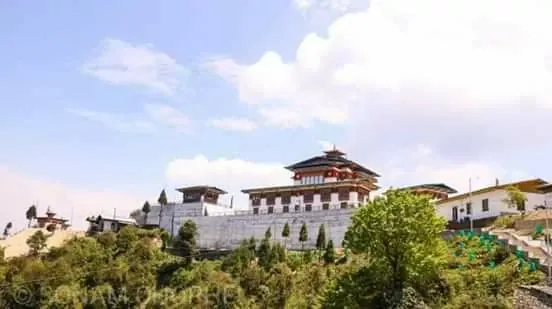 |
| Yongla Gonpa Courtesy: Facebook. |
One of the most notable Buddhist cloisters under Pemagatshel Dzongkhag in eastern Bhutan is the Yong-la Riwo Pelbar Dargeychhoeling Gonpa or the Pelri Gonpa, broadly referred to today as Yong-la Goenpa. It is serenely situated on a mountain overlooking the valley of Pema Gatshel. While travelling through the National Highway connecting Samdrup Jongkhar to Trashigang, one can get a look at the sanctuary from the intersection known as Tsheling-gore. From this intersection, it is less than an hour's drive to reach the cloister. The Second Yongla Lam Dorji Jamtsho is believed to have worked continuously and built the Yongla Gonpa cloisters in 1736. According to the traditions, that was actually a year after the demise of Khedrup Jigme Kuendel who distinguished, contemplated and favoured this hallowed spot adhering to the directions dependent on the vision of his master Rigzin Jigme Lingpa 1729-1798, an extraordinary Ter-toen (treasure revealer) and a Nyingma master.
Kheydrup Jigme Kundel originated from Darlung Kha in Wang, Thimphu in the Eighteenth Century. It is said that Jigme Lingpa was said to have asked Khedrup Jigme Kuendel to spot a place that resembled Tsari in Tibet that used to appear like Phurba (Ritual Dagger) where he was to spread the religious traditions and where his predetermination lay. Kheydrup Jigme Kuendel supposedly went from Tibet to Lho Kha Zhi (erstwhile name of Bhutan) via Bumthang searching for the predetermined spot until he arrived at the present-day Yong-la joined by Khandro Dechen Gyalmo. At the point when he inquired as to whether this was the destined spot forecasted by his lord, the Khandro replied, 'Yong, Yong', meaning 'Indeed, Yes'. From that point, the spot came to be known as Yong-la. Taking the agreement of Khandro Dechen Gyalmo (his accompany) and positive that he was in the correct spot, Jigme Kundel ruminated right away. Gradually, the place was visited by individuals from the close by places and became his devotees. Kheydrup Jigme Kundel benevolently rendered religious services to the people and in return, his devotees gathered endowments and offerings. The place started to become a famous Centre for meditation for the followers.
The well-known Yongla Phurpai Drubchen is an annual grandeur event (in September) in the locality and is said to have started during Kheydrup Jigme Kuendel, supported by the devoted inhabitants. In the later years, the tradition of Phurpai Drubchhen lost its essentialness under various successive Lams but was soon re-established back to the past brilliance by Lam Sonam Zangpo, the incomparable Yogi Master during the 1960s. Its essentialness topped indeed in 1970 after the visit of His Holiness Dudjom Rinpoche during which time His Holiness gave the present name, Pemagatshel: the Blissful place of the Lotus. Pema Gatshel Dzongkha took the initiative of building the Lhakhang which was completed in the late 1980s. According to the inhabitants, more than 16 Lams have filled in as the abbot of Yongla Gonpa to date. The famous Yongla Phurpai Drubchhen is a week-long celebration attracting thousands of visitors from other Dzongkhags as well. Today, the Goenpa is undergoing renovation after the devastating impact caused by an earthquake in 2009.
(Disclaimer: The research is undergoing and will be updated further)






0 Comments